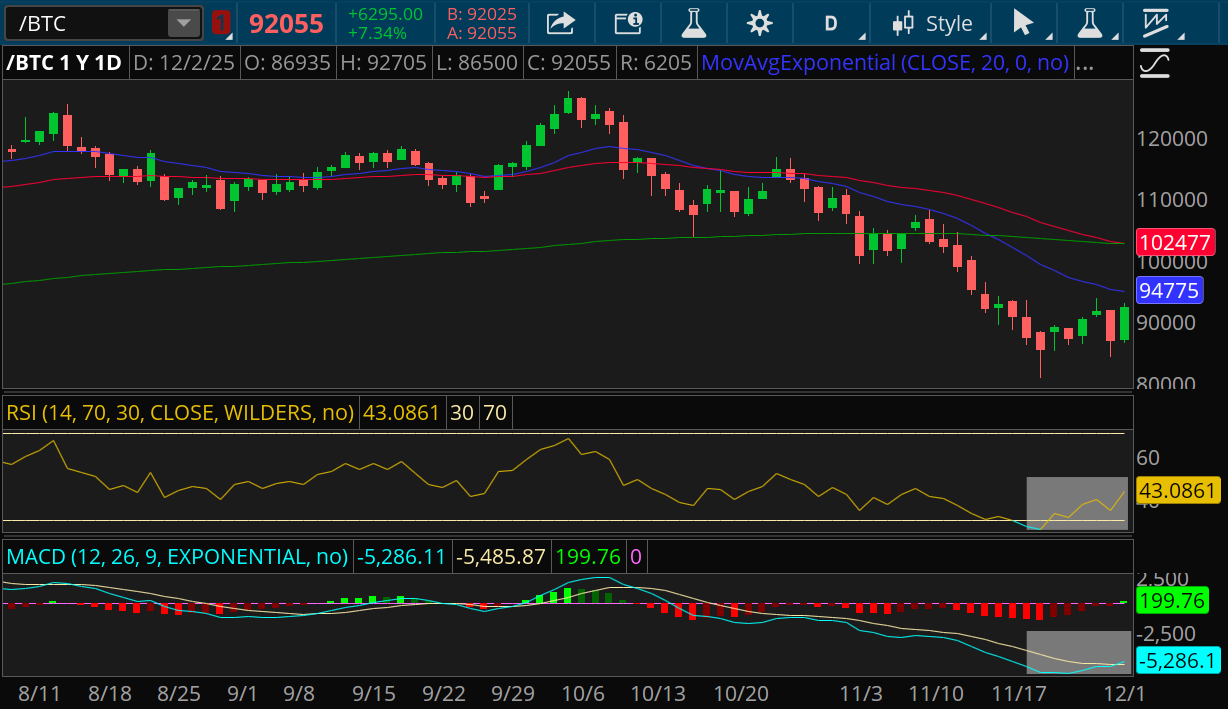Weak Jobs Data Lift Rate Cut Hopes as Stocks Climb

Published as of: December 3, 2025, 9:13 a.m. ET
Listen to this article
Listen here or subscribe for free to the Schwab Market Update in your favorite podcast app.
| The markets | Last price | Change | % change |
|---|---|---|---|
| S&P 500®index | 6,829.37 | +16.74 | +0.25% |
| Dow Jones Industrial Average® | 47,474.46 | +185.13 | +0.39% |
| Nasdaq Composite® | 23,413.67 | +137.75 | +0.59% |
| 10-year Treasury yield | 4.06% | -0.02 | -- |
| U.S. Dollar Index | 98.95 |
-0.40 |
-0.41% |
| Cboe Volatility Index® | 16.28 | -0.31 | -1.87% |
| WTI Crude Oil | $59.21 | +$0.57 | +0.99% |
| Bitcoin | $93,530 | +2,075 |
+2.27% |
(Wednesday market open) Stocks clung to early gains even as economic worries mounted following a surprise drop of 32,000 jobs in November's report from ADP. Analysts had expected growth of 10,000, with the private-sector ADP report attracting more focus than usual in the absence of official government data due to the shutdown. Losses were most prevalent at smaller businesses, ADP said.
"This morning's ADP report confirms that the labor market is cooling, but we still weigh the ADP release a bit less than the standard nonfarm payrolls report and unemployment rate from the Bureau of Labor Statistics," said Collin Martin, head of fixed income research and strategy, Schwab Center for Financial Research (SCFR). "The Fed was expected to cut rates next week regardless, but this further supports the case, even if it's just an 'insurance cut' meant to limit a further deterioration of the labor market." Futures trading now bakes in an almost 90% chance of a rate cut, according to the CME FedWatch Tool. OfficialNovember jobs data are due December 16.
Tuesday featured light gains led by tech and crypto as risk sentiment improved in low-volume trading. Still, the S&P 500® index remains below last week's close—and more names declined than advanced, raising questions about bullish conviction so close to all-time highs. Salesforce (CRM) and Snowflake (SNOW) wait in the wings after today's close following Marvell Technology (MRVL) and CrowdStrike's (CRWD) results late yesterday. Also, today offers investors a close-up look at holiday shopping trends as Macy's (M) reported.
To get the Schwab Market Update in your inbox every morning, subscribe on Schwab.com.
Three things to watch
- AI in focus as tech firms report: Salesforce reports today after a tough year that saw shares pull back on worries about AI competition. However, revenue climbed 10% in the quarter it reported three months ago, and Salesforce maintained its full-year revenue outlook while raising earnings guidance. This time, investors will likely watch performance of the company's Agentforce AI software for signs of Salesforce getting traction from its AI offerings. Another tech-related earnings report after today's close comes courtesy of enterprise software firm Snowflake (SNOW), shares of which have enjoyed a far better year than Salesforce. Shares of Snowflake rose double digits after its last earnings report as revenue and earnings topped estimates. The company guided for $1.13 billion in fiscal third-quarter product revenue. Investors likely want an update on usage of Snowflake's AI. More than 6,100 accounts use it every week, the company said in its last earnings report. The key near-term AI update likely comes late next Monday when Oracle (ORCL) reports. "Oracle earnings could be a binary event regarding the AI bull case, which could impact near-term investor sentiment," said Nathan Peterson, director of derivatives research and strategy, SCFR.
- Fresh price data ahead as yields dip: The 10-year U.S. Treasury note yield fell two basis points after the weak ADP data before facing more reports later. Notably, today's 10 a.m. ET November ISM Services Index could factor into Treasuries after prices paid topped 70 in the October report—the first reading above 70 in three years. Another reading that high might reinforce inflation concerns. More pressure on Treasuries before today came amid expectations of increased domestic bond issuance to finance government deficits. This week's rise to 17-year highs for Japanese yields added to pressure. "These factors, along with elevated inflation, should keep the 10-year Treasury note yield near 4% even as the Fed gradually cuts rates," said Martin, of SCFR. "Barring a recession, the downside might only be near 3.75%." A level to watch for the 10-year yield if it moves up again is 4.16%, which it topped twice in November and hasn't been above since October 7.
- Big bounce for bitcoin: Bitcoin rose as much as 6.8% Tuesday, its biggest one-day gain since May, and continued gaining overnight, topping $93,000. That followed a brutal selloff on Monday that was driven by concerns over a possible unwinding of the yen carry trade and the prospect of crypto treasury companies needing to sell some of their holdings in the event of further price declines. Monday's drop heightened talk of a bitcoin "winter," but on Tuesday the shorts appeared to be feeling the squeeze. As of midday Tuesday, short positions accounted for 95% of all bitcoin positions that had been liquidated on spot exchanges over the previous 12 hours, according to data from Coinglass. Still, bitcoin has just barely climbed above its 20-day simple moving average and remains well below its 50-day. Any sustained rise will require buying from long-term holders and exchange-traded funds (ETFs), said Jim Ferraioli, director of digital currencies research and strategy, SCFR.
On the move
Bitcoin futures (/BTC) advanced more than 6% yesterday and continued to ascend early today, adding another 2% to top $93,000. This could reflect growing "risk-on" sentiment around the market after Monday's retreat from risk assets that sent Bitcoin down 5%. While shares of crypto-related stocks including Coinbase (COIN), Strategy (MSTR), and Circle Internet Group (CRCL) all climbed 2% to 3% ahead of the open.
Macy's (M) sank 6% ahead of the open even though earnings per share and revenue topped Wall Street's consensus views and raised guidance. Shares had risen into earnings so today's action might represent "buy the rumor, sell the fact" trading.
Marvell Technology, a supplier of custom AI chips for Amazon (AMZN), climbed 9% in pre-market trading after quarterly results roughly matched consensus. Guidance looked solid, while data center revenue growth of 38% beat forecasts. Also, Marvell announced the $3.25 billion acquisition of chip start-up Celestial AI, which it said, "expands our leadership in AI connectivity." Several analysts raised their price targets for Marvell shares.
CrowdStrike (CRWD) slipped less than 1% early. Quarterly results slightly exceeded analysts' expectations, including a 22% year-over-year revenue rise. The important metric of annual recurring revenue rose to $4.92 billion, above consensus, Barron's noted.
American Eagle Outfitters (AEO) jumped 12% ahead of the open after the company raised its forecast and said it expects solid holiday sales driven by its marketing campaigns, Reuters reported. The company's shares got upgraded by JPMorgan Chase (JPM) to Neutral from Underweight.
Boeing soared 10% Tuesday after saying it expects positive free cash flow in 2026 and improved 737 and 787 deliveries.
Nvidia (NVDA) rose 1% early today after posting back-to-back gains for the first time in almost a month. Its last three-day win streak came in late October.
AI- and chip-related stocks were mostly higher early Wednesday, sometimes a leading indicator of daily market performance overall. Shares of CoreWeave (CRWV), Oracle (ORCL), Arm Holdings (ARM) and Super Micro Computer (SMCI) all rose more than 1%.
Netflix (NFLX) dipped 1.5% early Wednesday after Bloomberg reported that Warner Bros Discovery (WBD) fielded a second round of bids, including a mostly cash offer from Netflix. Warner Bros reportedly wants $30 a share, above its current $24.50 share price. Netflix is working on a bridge loan that totals tens of billions of dollars, Bloomberg reported, citing people involved in the discussions.
Uber (UBER) accelerated 2.5% this morning after it launched robotaxi rides in Dallas through a partnership with Avride. At launch, an onboard specialist will be monitoring behind the wheel before full driverless operations begin in the future, Uber said.
Only 52% of S&P 500 stocks trade above their 50-day moving averages, meaning market breadth remains relatively narrow rather than a rising tide lifting boats outside the leading tech and communication services arena.
More insights from Schwab

Washington update: Questions as Congress returns include whether legislators can make progress on key appropriations bills and if expiring health insurance subsidies get extended, says Michael Townsend, Schwab's managing director, legislative and regulatory affairs. He's also tracking bank regulation and a possible ban on stock trading for lawmakers. Read all about it in Townsend's latest Washington: What to Watch Now.
" id="body_disclosure--media_disclosure--249396" >Washington update: Questions as Congress returns include whether legislators can make progress on key appropriations bills and if expiring health insurance subsidies get extended, says Michael Townsend, Schwab's managing director, legislative and regulatory affairs. He's also tracking bank regulation and a possible ban on stock trading for lawmakers. Read all about it in Townsend's latest Washington: What to Watch Now.
Defensive no more? Utilities, long seen as a defensive sector, may be losing that reputation thanks to AI-related power demand that's lifted many of its components this year, Schwab reports in a new look at this trend.
0DTE basics: What are zero-days to expiration (0DTE) options? These strategies have become increasingly popular but also have drawn scrutiny from those who think it's caused volatility to rise. Read more in Schwab's new look at this corner of the options market.
Get expert insights on market drivers and their potential impact on your portfolio
Join us for this Schwab Coaching special event: the 2026 Market Outlook on December 11 at 7:00 p.m. ET. Just tune in to our media affiliate Schwab Network™ to see what our experts think might affect the markets next year.
Chart of the day

Data source: CME Group. Chart source: thinkorswim® platform.
Past performance is no guarantee of future results.
For illustrative purposes only.
The daily chart of bitcoin futures (/BTC—candlesticks) indicates sellers' grip may be softening after a decline of around 30%. Both the Relative Strength Index (RSI) and the Moving Average Convergence Divergence (MACD) indicator show downward momentum easing, particularly after Tuesday's bullish reversal (green candlestick at far right). But price remains below the 20-day simple moving average (blue line), not to mention the 50- and 200-day averages (red and green lines, respectively), meaning the bears are still in control.
The week ahead
Check out the investors' calendar for a summary of the top economic events and earnings reports on tap this week.
December 4: November Challenger Job Cuts and expected earnings from Kroger (KR), Dollar General (DG), and Hewlett Packard Enterprise (HPE).
December 5: September personal income and spending, September PCE and core PCE, October factory orders, and University of Michigan preliminary December consumer sentiment.
December 8: Expected earnings from Toll Brothers (TOL) and Oracle (ORCL).
December 9: Q3 Productivity, October Job Openings and Labor Turnover (JOLTS) survey and earnings from AutoZone (AZO), Ferguson Enterprises (FERG), Campbell's (CPB), Casey's General Stores (CASY), and GameStop (GME).
December 10: FOMC rate decision, FOMC projections, and expected earnings from Chewy (CHWY), Adobe (ADBE), and Synopses (SNPS).